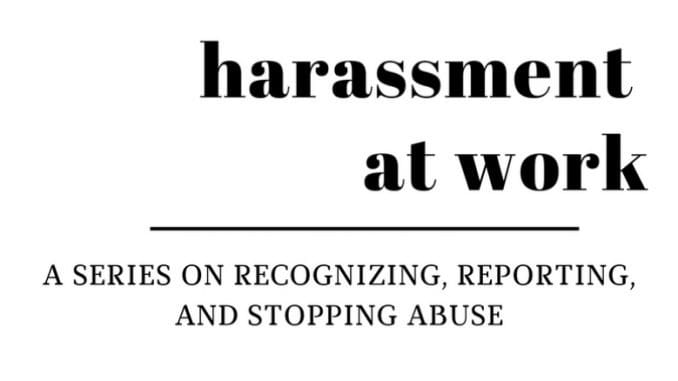
Harassment at work is real, but what do you do when it happens to you? How do you know when someone’s behavior has crossed the line? And who do you tell? In this eight-part series, we break down what harassment is and what to do about it.
BY ASHLEY RODRIGUEZ
BARISTA MAGAZINE ONLINE
Note: This series will explore issues of harassment and recount episodes of alleged harassment in the workplace. If you are sensitive to stories and scenarios depicting workplace harassment, please be advised.
This series is an accompaniment to the February + March 2018 article, “Coexisting at Work: Sexual Harassment Policies,” written by Lauren Lathrop. It’s meant to define sexual harassment and provide a blueprint as to how to handle workplace harassment. The first part of this series defined harassment, part two talked about legal protections and laws defining sexual harassment, and part three discussed the various forms of documenting harassment. Here in part four, we’ll talk about evidence—how it’s used, why it matters, and what qualifies as such.
In terms of harassment law, the burden of proof falls almost entirely on victims. As unfortunate, unfair, and potentially triggering as this is, it means that it is almost entirely up to victims of harassment in the workplace to prove that they have been treated unfairly. That’s where evidence comes in.
If you go back to part three of our series, we talked about documentation, but how does that translate to evidence? For any sort of documentation to be used as evidence, it must help prove the legal definition of harassment, which is:
- Unwanted behavior that is targeted toward an individual because they are part of a protected class (race, sex, and gender expression are just some examples). So if a coworker says unwanted things to you but says them also to a coworker who doesn’t belong to a protected class, it may not be considered harassment. However, if the coworker says something to you and only makes those comments either to you or to others from that protected class, that would qualify as harassment. Like our documentation article states, make sure to write the incident down or keep any emails or forms of correspondence.
- Repeated behavior. The legal definition of harassment states that the behavior must be extreme and create a hostile work environment. The law expects people to handle one-off situations, so evidence of harassment should include multiple accounts of unwanted behavior over a period of time long enough to be considered pervasive; a judge dismissed a court case where the plaintiff claimed he had been harassed over 10 days because the judge felt 10 days wasn’t “pervasive enough.” Likewise, a judge can rule that behaviors are sporadic if they occur over too long a period of time.
- Unwelcome. This one is tricky—so many harassment suits we read about online center around a narrative that the predator did what they did because they thought the behavior was welcome. Evidence should reflect that the victim did not want to be touched/talked to/on the receiving end of any form of behavior they are reporting and that the person committing the acts knew this. There are a few exceptions, especially when it comes to issues of power, like a boss intimidating an employee to not say anything about their behavior for fear that they might lose their job. That balance of power must be proven as well.
- Severe enough to affect your work. Sometimes, this is easy to prove. Like in the Four Barrel case against Jeremy Tooker, where some of his employees accused him of forcing them to kiss him at parties, there are certain behaviors that seem to need no explanation. But others may require showing that the behavior affected your ability to do your work—this one is really difficult to define since there’s no specific number or metric for severity. One very clear way, however, is to show that the behavior in question affected your ability to move up or be promoted at work, or caused you to be fired. That’s why documents that might not seem relevant, like performance reviews, can be considered evidence in these situations.
No magic formulation of these four points will add up to a definite, unequivocal court case. In fact, only about 3 to 6 percent of harassment cases ever see a courtroom. Judges retain the right to throw cases out, so even if you want to go ahead and prosecute and the court is willing to hear your case, there’s a chance that a judge might think otherwise.
A lot of this feels discouraging. But just because evidence might not prove a case in court doesn’t mean you shouldn’t be collecting it. Many harassment cases are settled out of court, and sometimes public knowledge of an incident is enough to change the trajectory of a business or change ownership (although the Four Barrel case never went to court, Jeremy Tooker is no longer involved with the business, and allegations against Harvey Weinstein were immediately felt in the media long before Weinstein was ever charged with a crime).
This article might be difficult to read, especially because it doesn’t provide a ton of hope for justice. Unlike a murder case or some other form of assault, workplace harassment cases don’t get detectives working on them trying to figure out the truth, and the fact of the matter is that legalities can get in the way of providing relief. That’s why it’s important to be as clear as possible with the evidence you collect, and to know exactly what you need to take your workplace predator to task.
In the next piece, we’ll focus on what to do if you see harassment—what it means to be a bystander and how you can safely intervene.
Disclaimer: This article is meant to be informative and provide guidance. This is not meant to be legal advice. This publication is read by a variety of people all over the world, and laws regarding workplace harassment can vary wildly. If you are thinking about filing a workplace harassment lawsuit, please consult a licensed attorney in your state or jurisdiction.

